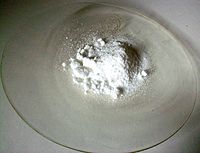- Sodium persulfate
-
Sodium persulfate  Other namessodium peroxodisulfate
Other namessodium peroxodisulfate
sodium peroxodisulphate
sodium peroxydisulfate
sodium peroxydisulphateIdentifiers CAS number 7775-27-1 
PubChem 62655 ChemSpider 56406 
EC number 231-892-1 UN number 1505 ChEMBL CHEMBL502764 
RTECS number SE0525000 Jmol-3D images Image 1 - [Na+].[Na+].O=S(=O)([O-])OOS([O-])(=O)=O
Properties Molecular formula Na2S2O8 Molar mass 238.03 g/mol Appearance white powder Density 2.40 g/cm3 Melting point 180 °C decomp.
Solubility in water 55.6 g/100 ml (20°C) Hazards MSDS ICSC 1136 EU Index Not listed R-phrases R8 R20 R22 R36 R37 R38 S-phrases S17 S26 S36 NFPA 704 Flash point Non-flammable Related compounds Other anions Sodium dithionite
Sodium sulfite
Sodium sulfateOther cations Potassium persulfate  persulfate (verify) (what is:
persulfate (verify) (what is:  /
/ ?)
?)
Except where noted otherwise, data are given for materials in their standard state (at 25 °C, 100 kPa)Infobox references Sodium persulfate (Na2S2O8) is a chemical compound. It is a strong oxidizer. It is a severe irritant of skin, eyes, and respiratory system. It is almost non-hygroscopic and has particularly good ability to be stored for long time. It is easy and safe to handle. It is not combustible, but releases oxygen easily and assists combustion of other materials.
It is used as a bleach, both standalone (particularly in hair cosmetics) and as a detergent component. It is a replacement for ammonium persulfate in etching mixtures for zinc and printed circuit boards, and is used for pickling of copper and some other metals. It is a source of free radicals, making it useful as a radical initiator for emulsion polymerization reactions and for accelerated curing of low formaldehyde adhesives. It is also used as a soil conditioner and in manufacture of dyestuffs, modification of starch, bleach activator, desizing agent for oxidative desizing, etc.
Conditions/substances to avoid mixing persulfates with are: moisture, heat, flame, ignition sources, shock, friction, reducing agents, organic material, sodium peroxide, water, aluminium, and powdered metals.
Sodium persulfate is a oxidizing agent in chemistry, for example in a synthesis of diapocynin from apocynin where iron(II) sulfate is the radical initiator:[1]
The sulfate radical formed in situ has a standard electrode potential of 2.7 V.
References
- ^ Luchtefeld, Ron; Dasari, Mina S.; Richards, Kristy M.; Alt, Mikaela L.; Crawford, Clark F. P.; Schleiden, Amanda; Ingram, Jai; Hamidou, Abdel Aziz Amadou et al. (2008). "Synthesis of Diapocynin". J. Chem. Ed. 85 (3): 411. doi:10.1021/ed085p411.
Sodium compounds NaAlO2 · NaBH3(CN) · NaBH4 · NaBr · NaBrO3 · NaCH3COO · NaCN · NaC6H5CO2 · NaC6H4(OH)CO2 · NaCl · NaClO · NaClO2 · NaClO3 · NaClO4 · NaF · NaH · NaHCO3 · NaHSO3 · NaHSO4 · NaI · NaIO3 · NaIO4 · NaMnO4 · NaNH2 · NaNO2 · NaNO3 · NaN3 · NaOH · NaO2 · NaPO2H2 · NaReO4 · NaSCN · NaSH · NaTcO4 · NaVO3 · Na2CO3 · Na2C2O4 · Na2CrO4 · Na2Cr2O7 · Na2MnO4 · Na2MoO4 · Na2O · Na2O2 · Na2O(UO3)2 · Na2S · Na2SO3 · Na2SO4 · Na2S2O3 · Na2S2O4 · Na2S2O5 · Na2S2O6 · Na2S2O7 · Na2S2O8 · Na2Se · Na2SeO3 · Na2SeO4 · Na2SiO3 · Na2Te · Na2TeO3 · Na2Ti3O7 · Na2U2O7 · NaWO4 · Na2Zn(OH)4 · Na3N · Na3P · Na3VO4 · Na4Fe(CN)6 · Na5P3O10 · NaBiO3
Categories:- Persulfates
- Sodium compounds
- Oxidizing agents
Wikimedia Foundation. 2010.




